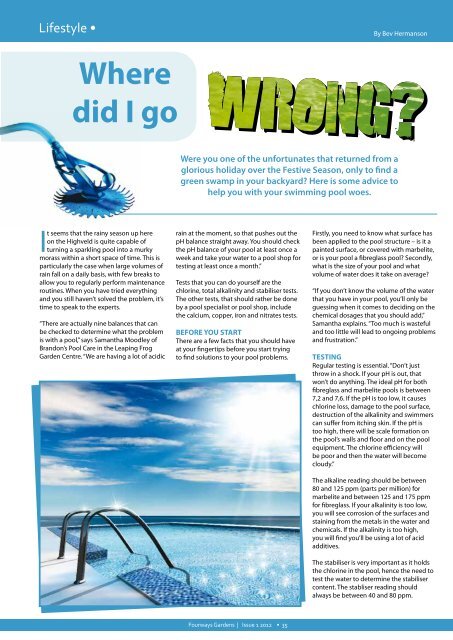Download Magazine - fwg.co.za
Download Magazine - fwg.co.za
Download Magazine - fwg.co.za
Create successful ePaper yourself
Turn your PDF publications into a flip-book with our unique Google optimized e-Paper software.
Lifestyle • By Bev Hermanson<br />
Where<br />
did I go<br />
It seems that the rainy season up here<br />
on the Highveld is quite capable of<br />
turning a sparkling pool into a murky<br />
morass within a short space of time. This is<br />
particularly the case when large volumes of<br />
rain fall on a daily basis, with few breaks to<br />
allow you to regularly perform maintenance<br />
routines. When you have tried everything<br />
and you still haven’t solved the problem, it’s<br />
time to speak to the experts.<br />
“There are actually nine balances that can<br />
be checked to determine what the problem<br />
is with a pool,” says Samantha Moodley of<br />
Brandon’s Pool Care in the Leaping Frog<br />
Garden Centre. “We are having a lot of acidic<br />
Were you one of the unfortunates that returned from a<br />
glorious holiday over the Festive Season, only to find a<br />
green swamp in your backyard? Here is some advice to<br />
help you with your swimming pool woes.<br />
rain at the moment, so that pushes out the<br />
pH balance straight away. You should check<br />
the pH balance of your pool at least once a<br />
week and take your water to a pool shop for<br />
testing at least once a month.”<br />
Tests that you can do yourself are the<br />
chlorine, total alkalinity and stabiliser tests.<br />
The other tests, that should rather be done<br />
by a pool specialist or pool shop, include<br />
the calcium, <strong>co</strong>pper, iron and nitrates tests.<br />
BEFORE YOU START<br />
There are a few facts that you should have<br />
at your fingertips before you start trying<br />
to find solutions to your pool problems.<br />
Fourways Gardens | Issue 1 2012 • 35<br />
Firstly, you need to know what surface has<br />
been applied to the pool structure – is it a<br />
painted surface, or <strong>co</strong>vered with marbelite,<br />
or is your pool a fibreglass pool? Se<strong>co</strong>ndly,<br />
what is the size of your pool and what<br />
volume of water does it take on average?<br />
“If you don’t know the volume of the water<br />
that you have in your pool, you’ll only be<br />
guessing when it <strong>co</strong>mes to deciding on the<br />
chemical dosages that you should add,”<br />
Samantha explains. “Too much is wasteful<br />
and too little will lead to ongoing problems<br />
and frustration.”<br />
TESTING<br />
Regular testing is essential. “Don’t just<br />
throw in a shock. If your pH is out, that<br />
won’t do anything. The ideal pH for both<br />
fibreglass and marbelite pools is between<br />
7,2 and 7,6. If the pH is too low, it causes<br />
chlorine loss, damage to the pool surface,<br />
destruction of the alkalinity and swimmers<br />
can suffer from itching skin. If the pH is<br />
too high, there will be scale formation on<br />
the pool’s walls and floor and on the pool<br />
equipment. The chlorine efficiency will<br />
be poor and then the water will be<strong>co</strong>me<br />
cloudy.”<br />
The alkaline reading should be between<br />
80 and 125 ppm (parts per million) for<br />
marbelite and between 125 and 175 ppm<br />
for fibreglass. If your alkalinity is too low,<br />
you will see <strong>co</strong>rrosion of the surfaces and<br />
staining from the metals in the water and<br />
chemicals. If the alkalinity is too high,<br />
you will find you’ll be using a lot of acid<br />
additives.<br />
The stabiliser is very important as it holds<br />
the chlorine in the pool, hence the need to<br />
test the water to determine the stabiliser<br />
<strong>co</strong>ntent. The stabliser reading should<br />
always be between 40 and 80 ppm.




